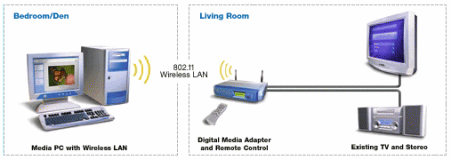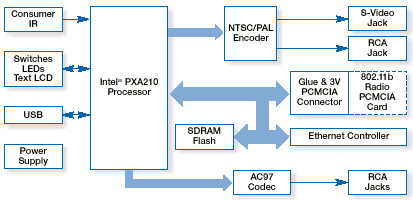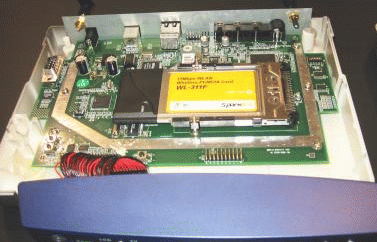Article: Intel embeds Linux in home digital media adapter
Sep 10, 2002 — by LinuxDevices Staff — from the LinuxDevices Archive — viewsSan Jose, CA; Intel Developer Forum — Intel announced the 'Extended Wireless PC Initiative' which is described as “the first step of an initiative that is intended to aid distribution of digital media throughout the home.” The initiative provides several key building blocks and toolkits to the developer community, in an effort to speed the development of devices that can seamlessly distribute PC digital… media to TVs and stereos throughout the home. Intel and several vendors (including Mitac, Legend, Gateway, and Dell) demonstrated product concepts, reference designs, and software toolkits associated with the initiative.

Extended Wireless PC Initiative system components
A key component of the Extended Wireless PC Initiative's media distribution architecture is a new PC peripheral called the digital media adapter, which provides an appliance-like link between PCs, TVs, and stereos. The device, which is based on an XScale microarchitecture PCA210 'applications processor' and runs an embedded Linux operating system, receives digital media from the PC via 802.11 wireless networking and UpnP technologies, and connects to TVs and stereos using standard audio/video cables — much like a DVD player. Using a simple remote control, consumers navigate through menus on a TV screen, selecting the PC digital media they wish to receive.
According to Intel, this tightly integrated approach to digital media distribution in the home will be easy to install, perform multiple functions, and be offered at attractive consumer price points.
Technology building blocks
To accelerate the development of digital media adapters and extended wireless PC platforms, Intel announced immediate availability of the following technology building blocks and toolkits . . .
- A sample digital media adapter reference design, based on the Intel PXA210 applications processor. The sample design provides support for JPEG, MP3, and WMA digital content, utilizes 802.11b wireless networking, and supports NTSC/PAL/S-video TV connections and AC-97 stereo connection.
- Technical specifications describing an experimental media distribution software stack utilizing industry standard UPnP technologies. The UPnP-compliant software stack provides easy access to the PC's digital content using a digital media adapter.
- UPnP technology toolkits with support for several operating systems and authoring environments.
Details on these building blocks and toolkits are available from Intel's Digital Home developer website.

Front view of the digital media adapter
About the digital media adapter
In order for existing TVs and stereos to be able to play digital content, a digital media adapter is required to receive the content from the PC and send control information back to the PC. The digital media adapter connects to TVs and stereos anywhere in the house with simple audio and video cables, and uses wireless networking technology to exchange digital media and control information with the PC.
Intel has created a digital media adapter reference design which is said to “maximize developer flexibility while minimizing product costs.” The PXA210 XScale processor was chosen based on its integrated USB client port, LCD controller, AC97, I2C, GPIO, and serial ports. Linux was selected as the embedded operating system “because it runs on multiple embedded processors, is extensible, is open source, and has no licensing fees.”

Rear view of the device, showing input/output connections

Digital media adapter hardware block diagram
Embedded software engineer Jack Weast, who worked on Intel's digital media adapter reference design, said Intel developed the device's embedded Linux operating system (currently kernel 2.4.17) starting from a Red Hat distribution, which they slimmed down so that it could fit in the system's onboard 2MB Flash memory, and tailored to the other unique requirements of the device.
The BusyBox utility suite and uClibc libraries were used to minimize both Flash and RAM requirements, leaving as much of the 16MB of RAM available for the required application software stack. Drivers for AC97 audio and NTSC video were added, along with the Intel-created open source UPnP stack (currently hosted at SourceForge).
The software stack is insulated from the hardware by a layer of firmware comprising an OAL (ODM Adaptation Layer) and drivers. Developers can therefore easily modify the hardware to meet their company's needs, with changes to software limited to drivers for the modified hardware and updates to the OAL to integrate the new drivers.

Internal electronics of the digital media adapter
When can I get one? . . . and for how much?
Intel expects consumer versions of the digital media adapter to begin showing up during 2003.
Based on an estimated total bill-of-materials (BOM) cost in the neighborhood of $79, Intel anticipates that PC vendors will bundle the media adapters with multimedia PCs in order to allow consumers to deliver music and video to their entertainment centers from their PCs.
This article was originally published on LinuxDevices.com and has been donated to the open source community by QuinStreet Inc. Please visit LinuxToday.com for up-to-date news and articles about Linux and open source.